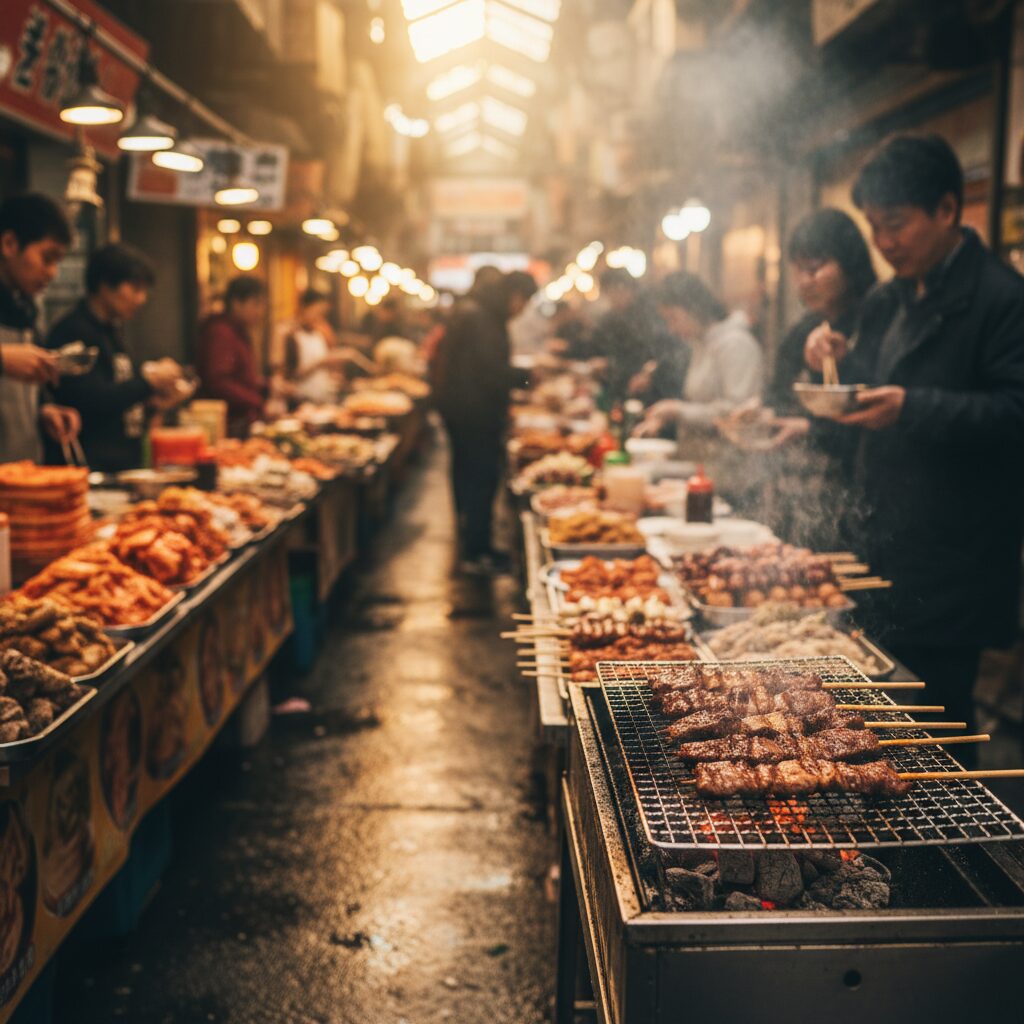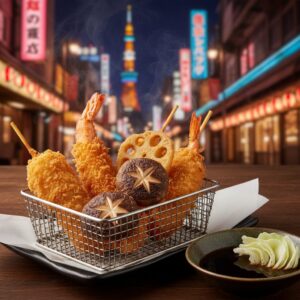Step off the train at Tsuruhashi Station, and you’re not just stepping onto a platform; you’re stepping into another world. The air changes instantly. It’s thick, complex, and utterly intoxicating, a heady perfume of sizzling garlic, savory grilled meat, and the sharp, funky promise of fermenting kimchi. This isn’t the sleek, polished Japan of guidebooks. This is Tsuruhashi Market, Osaka’s sprawling, chaotic, and profoundly soulful Koreatown, a place where history breathes through every narrow alleyway and flavor tells a story a century in the making. It’s a sensory overload in the most magnificent way possible, a labyrinth of over 800 shops crammed into a web of covered shotengai arcades that feel like they were carved from time itself. Forget pristine food courts and curated experiences; Tsuruhashi is raw, real, and unapologetically delicious. It’s a place for adventurers, for eaters, for anyone who believes that the true heart of a city beats loudest in its markets. Here, the pursuit of the next incredible bite is a journey through culture, community, and the vibrant, beating heart of Osaka’s culinary underground. It’s a place you don’t just visit; you feel it, taste it, and let it swallow you whole.
To fully immerse yourself in this vibrant district, it’s essential to have a comprehensive guide to navigating Tsuruhashi Market and its culinary treasures.
Echoes of the Past: The Spirit Forged in Post-War Osaka
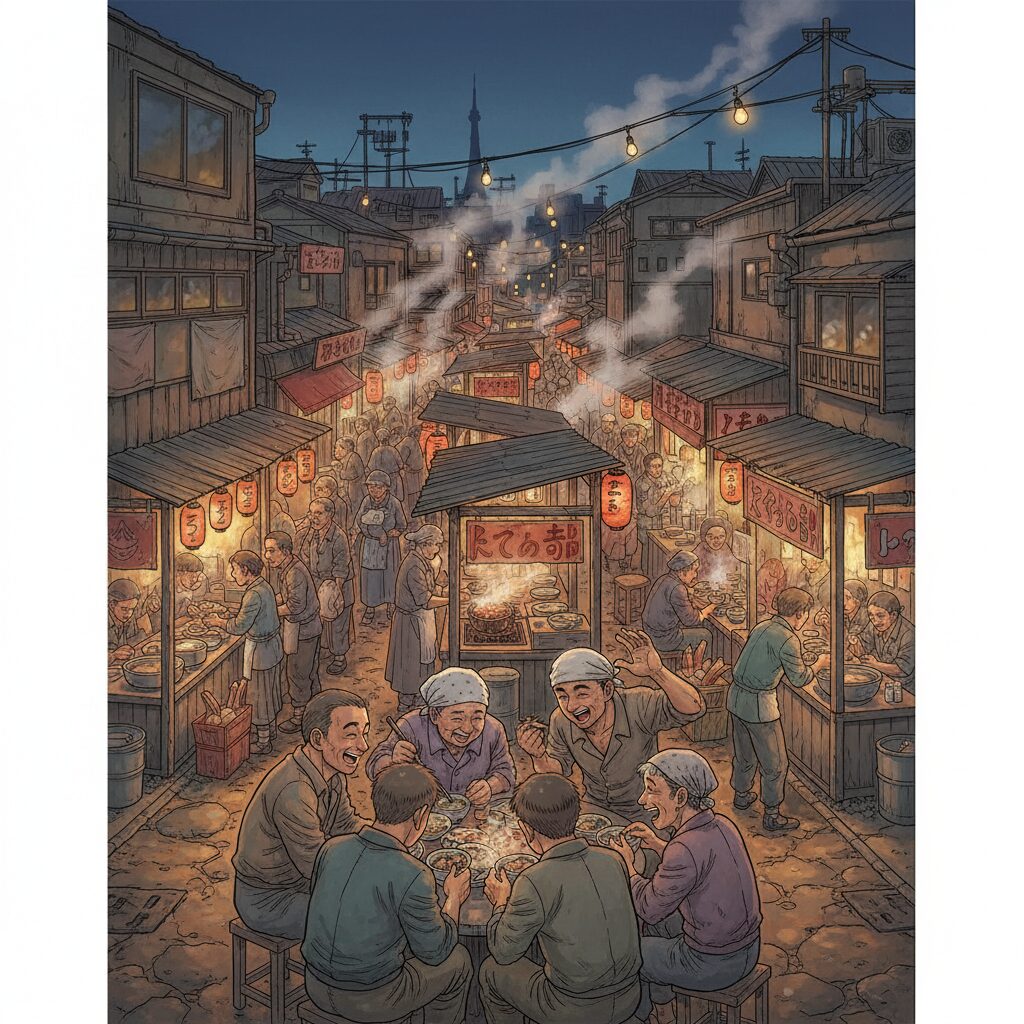
To truly grasp Tsuruhashi, you must listen to the echoes of its past. This market is not a modern invention; it emerged from necessity and resilience amid the ruins of post-war Japan. The area has long been home to one of Japan’s largest Zainichi Korean communities—ethnic Koreans who settled in Japan, many arriving in the early 20th century. In the harsh years following World War II, when food was scarce and resources limited, the district around Tsuruhashi Station became a crucial hub. It began as a yamiichi, or black market, where people traded for essential goods, sought hot meals, and forged a livelihood in a world turned upside down. The rich, comforting flavors of Korean cuisine, especially nutrient-dense, protein-rich dishes like horumon-yaki (grilled offal), became a pillar of this growing community. These meals were not just food; they were sustenance for survival, a reminder of home, and proof of the resourcefulness of a people determined to thrive.
This history is not mere background; it is embedded in the very fabric of the market. The maze-like alleys are direct descendants of those early, spontaneously set-up stalls. The strong scent of yakiniku filling the air ties directly back to the horumon grills that supported a generation. As you wander through the winding paths, you are moving through living history. It is reflected in the faces of the elderly shopkeepers, many second or third-generation owners, their hands moving with the skilled ease developed over a lifetime perfecting a single recipe. It resonates in the lively conversations, a seamless blend of Japanese and Korean that forms a unique local dialect. This is why Tsuruhashi stands apart from other markets in Japan. It is not just a place for commerce; it is a stronghold of cultural identity, a vibrant enclave preserving its heritage while becoming an essential part of Osaka’s diverse mosaic. Every stall, every sizzling grill, every pile of vibrant kimchi tells a chapter in a profound story of community, perseverance, and the universal language of extraordinary food.
Navigating the Labyrinth: An Eater’s Guide to Getting Lost
The first thing to accept when visiting Tsuruhashi Market is that you will inevitably get lost—and that’s exactly the point. The market sprawls across six main shopping streets and countless smaller offshoots, each boasting its own unique vibe. Toss aside your map and let your senses lead the way. The best strategy is to dive right in and let curiosity guide you from one alley to another. The main streets are lively and bright, filled with shops selling everything from colorful chima jeogori (traditional Korean dresses) to K-pop merchandise and Korean cosmetics. However, the true charm lies in venturing into the narrower, dimmer side streets.
These smaller lanes hold the true heart of Tsuruhashi’s street food culture. The air thickens with steam and smoke, the sounds of chopping and sizzling become your soundtrack, and the crowds press close, creating a shared energy of culinary exploration. For first-timers, I recommend starting near the West Exit of JR Tsuruhashi Station, which places you right in the middle of the action. Don’t hesitate. Vendors are used to curious visitors and are typically warm and welcoming, though their primary focus remains on expertly preparing their food. Wear your most comfortable shoes since the floors are uneven and you’ll likely be on your feet for hours. The market is largely cash-based; while some larger shops may accept cards, the small family-run food stalls—the market’s soul—mostly operate exclusively in yen. Carrying plenty of small bills and coins will ensure a smooth grazing experience. As a solo traveler, I find the vibrant chaos energizing, but it’s wise to stay aware of your surroundings. Keep your bag secure and be ready for the ebb and flow of the crowd, especially during peak lunch hours and on weekends when the market is at its liveliest.
The Savory Symphony: A Deep Dive into Tsuruhashi’s Street Food Stalls
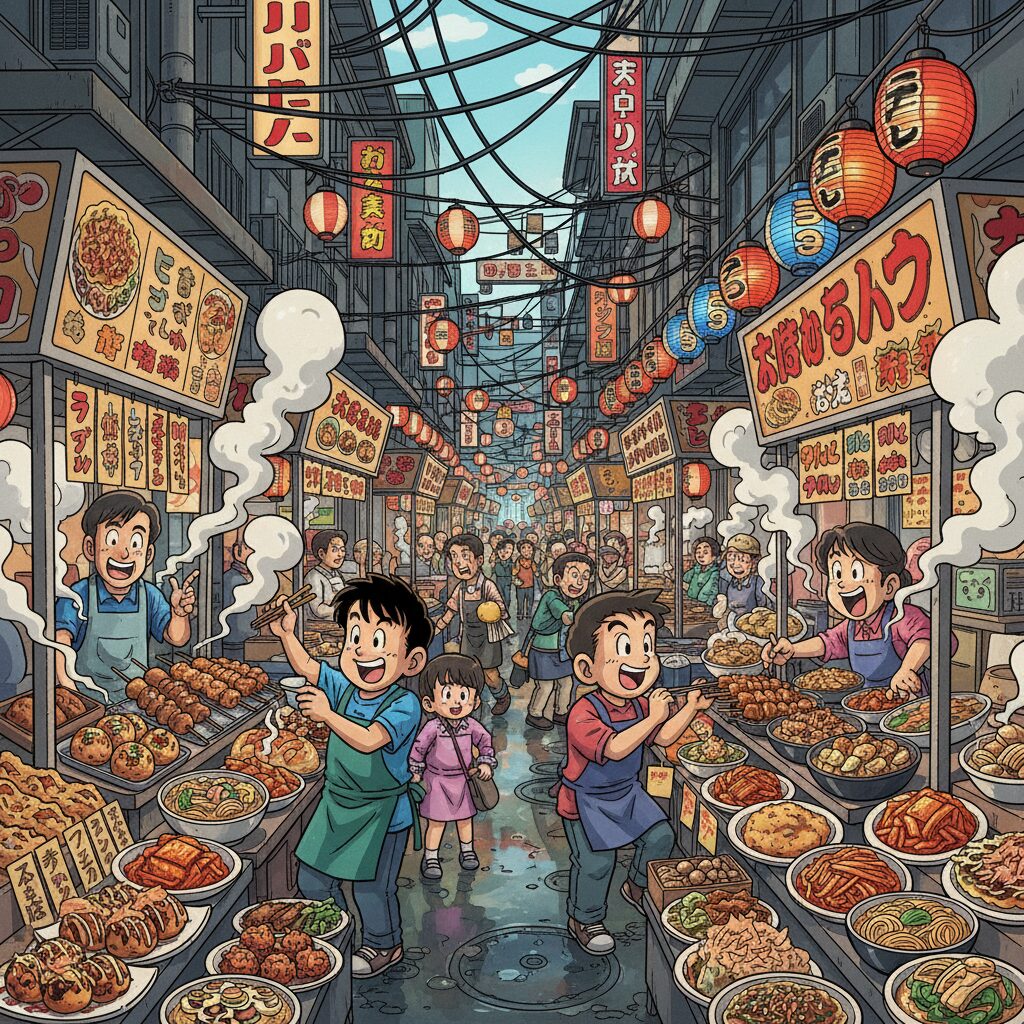
Your culinary journey begins the moment you step into the covered arcades. Let the enticing aromas lead the way. The first thing likely to catch your eye is the overwhelming, magnificent presence of kimchi. Tsuruhashi is often nicknamed Kimchi Yokocho (Kimchi Alley) for good reason. You’ll find entire storefronts devoted to it, with huge piles heaped high in massive tubs. But this isn’t just the typical cabbage kimchi you see in supermarkets. Here, the variety is astonishing. There’s crisp cucumber kimchi (oi sobagi), crunchy radish kimchi (kkakdugi), and even more unusual types made with squid or mountain vegetables. Many stalls offer small samples, a gracious gesture of hospitality that lets you taste each family’s unique recipe—some are fiery and bold, others subtly sweet and tangy. Buying a small portion to take home is a must, but the real delight is watching the ajumma (a respectful Korean term for a middle-aged woman) skillfully pack it for you, her hands moving swiftly.
The Sizzle of the Griddle: Chijimi and Tteokbokki
Further inside, listen for the steady sizzle and scrape of metal on a hot griddle. You’ve probably stumbled upon a chijimi stand. These savory Korean pancakes are a staple of Tsuruhashi street food. Forget the thin, delicate crepes you might imagine. The chijimi here tend to be thick, hearty, and wonderfully rustic, with crispy, golden-brown edges giving way to a soft, chewy center studded with ingredients. A classic choice is the seafood and green onion variety (haemul pajeon), loaded with plump shrimp and squid, its savory flavor perfectly offset by the sweet sharpness of the onions. The batter recipe is a closely guarded secret, creating a texture that is both substantial and light. It’s served piping hot, sliced into handy squares, and accompanied by a tangy soy-based dipping sauce. Watching the pancakes being made is part of the fun—a ladle of batter is poured onto a large, well-oiled flat-top grill, ingredients are scattered on top, and it’s cooked until perfectly crisp. It’s ultimate comfort food, ideal for eating on the go as you continue your exploration.
Just a few steps away, you might spot a bubbling pot of fiery red sauce. This is the territory of tteokbokki: chewy cylindrical rice cakes simmered in a sweet and spicy gochujang-based sauce. It’s a beloved Korean street food classic, and Tsuruhashi does it right. The rice cakes are tender with a satisfying chew, and the sauce clings to every piece, delivering a perfect blend of heat, sweetness, and umami. Often, fish cakes (eomuk) are simmered alongside, soaking up all that rich flavor. It’s served in a paper cup with a wooden skewer, making for a convenient and wonderfully messy snack. Beware, the spice can be intense, but it’s a warming heat that penetrates from within. For a milder but equally delicious option, look for stalls selling gyeran-ppang, sweet and savory bread filled with a whole egg—a delightful, portable treat.
The Art of the Roll: Kimbap and Mandu
If you want something more filling yet still easy to carry, watch for the kimbap experts. Kimbap are Korean seaweed rice rolls, often mistaken for Japanese sushi, but they are a distinct culinary tradition. The rice is typically seasoned with sesame oil and salt rather than vinegar, and the fillings are a colorful assortment of cooked ingredients. A classic Tsuruhashi kimbap might include seasoned spinach, pickled radish, carrots, egg, and marinated beef (bulgogi). Each ingredient is carefully prepared and layered, then rolled tightly in a glossy sheet of seaweed. Vendors display long rows of these beautiful rolls behind glass, each one a work of art. They slice them to order, revealing the vibrant cross-section of colors and textures. It’s a complete meal in a roll: savory, slightly sweet, and highly satisfying. Grabbing a kimbap roll is a great way to fuel up for a longer exploration of the market since it’s easy to eat while walking.
Nearby, you might see steam rising from large bamboo or stainless steel steamers. Here you’ll find mandu, Korean dumplings. These come filled with various ingredients, but a popular and delicious type is kimchimandu, which contains a spicy, savory filling of minced pork, tofu, and, naturally, kimchi. The dumplings can be steamed for a soft, tender texture or pan-fried until the bottoms are golden and crispy (gun-mandu). They are bite-sized parcels of flavor, perfect for popping into your mouth as you wander. The contrast between the delicate wrapper and the rich, textured filling is simply heavenly. It’s humble food, but when prepared well, mandu becomes one of the most memorable bites in the market.
The Heart of Fire: Yakiniku, Horumon, and the Scent of the Grill
While the main arcades offer a treasure trove of snacks and kimchi, a distinct world awaits in the smaller, more rugged alleys devoted to yakiniku (grilled meat). This is the historical and spiritual heart of Tsuruhashi. Here, the air is thick with fragrant smoke, and the sizzle of meat fills the atmosphere. Many of these establishments are tiny, often consisting of just a grill, a counter, and a few stools, with eager customers lined up spilling into the lane. This is where you’ll find some of the best and most affordable grilled meat in Osaka.
The highlight is horumon, a broad term for beef and pork offal. Though it may seem intimidating to newcomers, it is a local delicacy, deeply rooted in the area’s history as a way to utilize every part of the animal. You’ll encounter everything from heart (hatsu) and liver (rebā) to various intestines, each offering its own unique texture and flavor. The meat is often marinated in a secret family recipe combining soy sauce, garlic, ginger, and other spices before being grilled to perfection over charcoal or gas. The result is incredibly flavorful, with a smoky char and rich, savory taste. For the less adventurous, there are plenty of classic cuts like kalbi (short ribs) and harami (skirt steak), all exceptionally tender and delicious.
Don’t hesitate to try one of the standing-only grill spots. You simply point to the cuts you want from the display case, and they’ll grill them for you right there. It’s a communal, no-frills experience that is quintessentially Tsuruhashi. You’ll find yourself elbow-to-elbow with locals, all relishing the simple joy of perfectly grilled meat. This is where a little boldness pays off. Point to what the person next to you is enjoying, or just ask for the ‘osusume’ (recommendation). You might uncover your new favorite dish. This fiery, smoky corner of the market stands as a tribute to Tsuruhashi’s working-class roots and its enduring passion for bold, powerful flavors.
Beyond the Food: Textiles, Trinkets, and Hidden Cafes

Tsuruhashi is undeniably a paradise for food lovers, but it offers much more than just dining. As you stroll through the market, you’ll discover a vibrant mix of various goods. Among the food stalls, there are shops showcasing colorful Korean textiles, traditional pottery, and sleek stainless steel kitchen utensils such as the long-handled spoons and chopsticks essential for a Korean meal. Stores brimming with colorful chima jeogori, their silk gleaming under the arcade’s fluorescent lights, create a visual feast and a deeper cultural connection within the market.
Be sure to also watch for the small, almost hidden cafes and sweet shops that provide a peaceful break from the sensory overload. Nestled in quiet corners, you might come across a traditional Korean tea house serving calming jujube tea or a modern café seamlessly blending into the old-world ambiance. One of the most popular treats to seek out is hotteok, a sweet pancake typically filled with brown sugar, cinnamon, and chopped nuts. As it cooks on the griddle, the filling melts into a molten, syrupy delight wrapped in chewy, crispy dough. Spotting a hotteok stall feels like uncovering a sweet secret—a perfect way to conclude your savory adventures. These quieter spots offer a different view of Tsuruhashi, revealing its gentler, more reflective side. Taking a moment with a cup of tea or a sweet treat allows you to soak in the ambiance, watch the flow of people, and truly appreciate the market’s incredible, multifaceted world.
Practical Wisdom for the Intrepid Explorer
A trip to Tsuruhashi is an adventure, and a bit of preparation can make it even more enjoyable. Getting there is very easy. Tsuruhashi Station is a major hub served by the JR Osaka Loop Line, the Kintetsu Nara Line, and the Sennichimae Subway Line, making it accessible from almost anywhere in the city. The ideal time to visit is from mid-morning to late afternoon. Many shops open around 10:00 AM and begin closing around 5:00 or 6:00 PM. Keep in mind that many stalls and shops are closed on Wednesdays, so it’s best to plan your visit on another day of the week to experience the market at its liveliest.
Regarding etiquette, the key is to be respectful and attentive. The alleys are narrow, so be mindful of your space and avoid blocking pathways. While taking photos is generally acceptable, it’s polite to be discreet, especially when photographing shopkeepers or their products up close. A nod and a smile can go a long way. As mentioned, cash is preferred, so come prepared. Finally, embrace the chaos. Tsuruhashi isn’t a place for strict plans. The greatest joys come from spontaneous discoveries—the stall you find by chance, the unfamiliar snack you decide to try on a whim. Let the market guide you—that’s the true Tsuruhashi experience.
A Final Taste of Authenticity
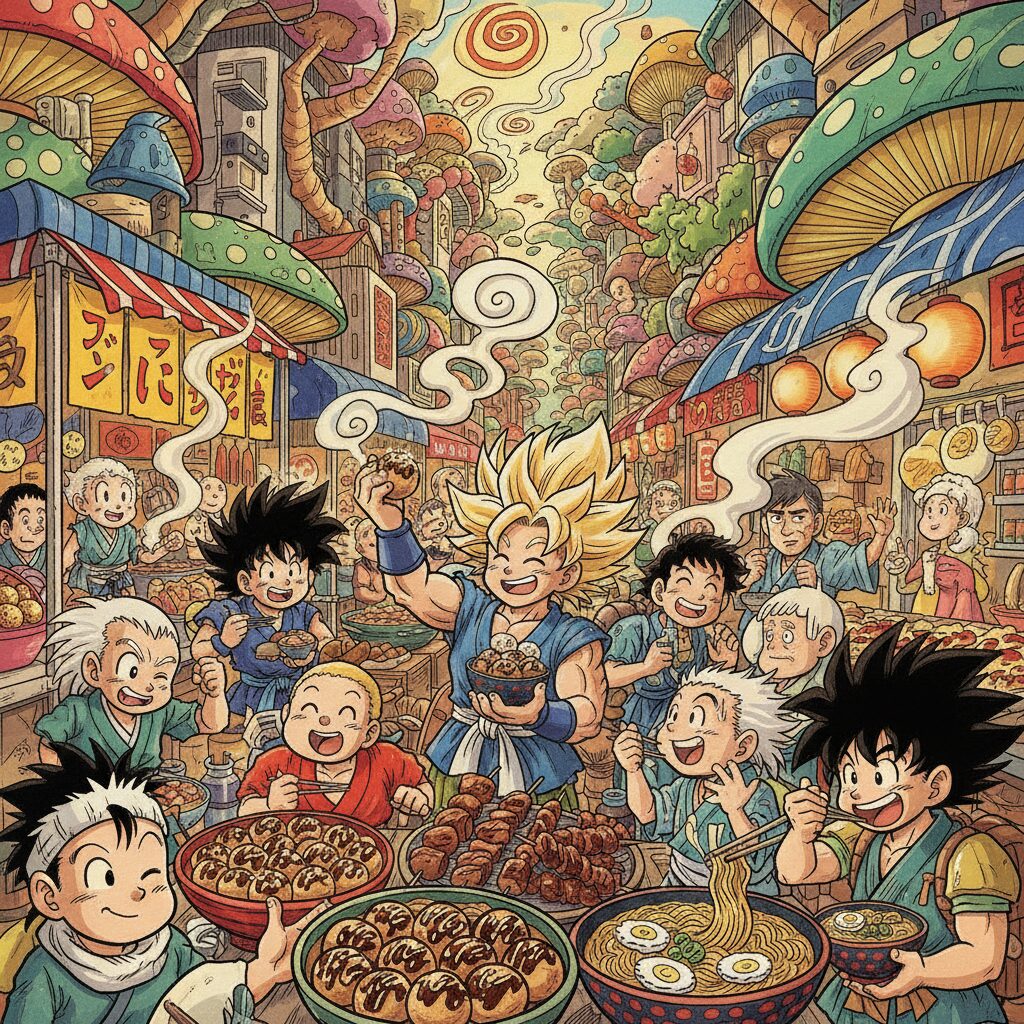
Leaving Tsuruhashi feels like emerging from a vivid dream. You step back onto the train platform, your clothes faintly scented with the smoky aroma of the grill, your bag filled with a treasure of kimchi, and your palate still buzzing with the complex flavors of your journey. This market is more than just a collection of shops; it is a living, breathing entity. It stands as a delicious, chaotic, and beautiful testament to the power of food to build community, preserve culture, and tell a story that transcends language. It is the raw soul of Osaka, a city proud of its love for good food and its down-to-earth, welcoming spirit. A visit to Tsuruhashi serves as a reminder that the most memorable travel experiences are rarely the most polished. They are the ones that engage all your senses, nudge you out of your comfort zone, and leave you with a taste of something authentic. So come hungry, come curious, and prepare to lose yourself in Japan’s most flavorful labyrinth.
